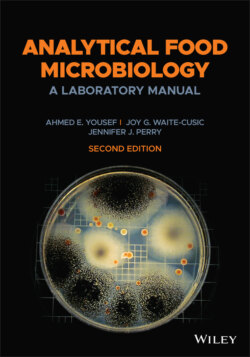Читать книгу Analytical Food Microbiology - Ahmed E. Yousef - Страница 52
Dilution
ОглавлениеDifferences in food’s microbial populations span several orders of magnitude, hence dilutions should be made before these populations can be measured with reasonable accuracy. To accomplish this task, an analytical sample is typically weighed, dilutions are made, and the count of microorganisms in the diluted sample is determined. The degree of dilution should be tracked carefully so that concentration of microorganisms in the undiluted food can be calculated. The degree of dilution (i.e., dilution factor) can be represented, generically, by the following equation:
(3.1)
Although weights can be measured with great accuracy, microbiologists prefer volumetric over gravimetric measurements because in the former, the analysis can be completed more quickly and aseptic techniques can be applied more easily. Furthermore, dilution is completed in multiple steps, typically in a decimal dilution series. To simplify the volumetric dilution procedure, the following approximations will be applied:
1 Food density is equal to 1 g/ml (at ambient temperature), therefore, food volume and mass will be considered numerically equal.
2 Final volume of diluted sample equals the sum of the volumes of the sample to be diluted and the diluent to be added.
With these practical considerations in mind, the equation above can be approximated as follows:
(3.2)
For example, a ten‐fold dilution (i.e., decimal dilution) of a food sample is prepared by mixing one part of the food with nine parts of a diluent, which commonly is a physiological saline solution or peptone water. Applying equation 3.2, the “dilution factor” for this diluted sample is 1/10 (i.e., one tenth) or 10–1.
The subsequent dilution, in a decimal dilution series, is made by mixing 1 ml of the first diluted sample with 9 ml diluent. The new mixture will have a total dilution of 1/100 (one hundredth) or 10–2. Note that exponents in a ten‐fold dilution scheme are additive, i.e., a 10–1 dilution followed by a subsequent 10–1 dilution yields a total dilution factor of 10–2. Additional dilutions are prepared as needed and the dilution factor, at any step of the series, can be calculated using equation 3.3.
(3.3)
Decimal dilution series are recommended for ease of calculation, but other ratios of weight (or volume) of a sample and diluent can be used. If a dilution in the series is not decimal (e.g., two‐fold dilution), the dilution factor of the new mixture can also be calculated using equation 3.3.
